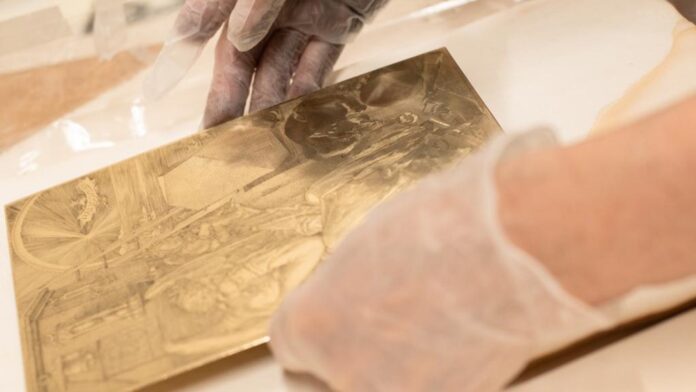Albrecht Dürer’s (1514) is one of the world’s most famous and mysterious prints. The immensely detailed engraving depicts the personification of ‘melancholy’—one of the four temperaments—in the form of a dejected, winged woman who is surrounded by the mechanical trappings of scientific theory and art production. She is further encircled by symbols that mark the passing of time, including an hourglass, sundial, an ailing dog and a ‘magic square’ calendar, all of which serve to amplify a sense of creative frustration.
The image captured the popular imagination in the artist’s city of Nuremberg and beyond, as the humanist philosophies of the Northern Renaissance flourished and a hunger for newly available printed imagery swept the merchant class. Although was disseminated widely, along with numerous copies and forgeries, the original printing plate is long lost, and scholarship concerning the exact meaning of this work of art has occupied academics for centuries.

Albrecht Dürer (1471 – 1528), Melencholia I (c. 1514). The Whitworth, The University of Manchester. Photo by Michael Pollard.
The history and context of this engraving has captured the imagination of Stockholm-based conceptual art duo Goldin+Senneby, following discussions with their long-term collaborator Ismail Ertürk, a cultural economist at Manchester Business School. He envisages as a “melancholia of finance” in which the respected tools of the banking industry have ultimately failed.
This theory became the starting point for a new project now on show across two new major exhibitions at the Whitworth Art Gallery: “Albrecht Dürer’s Material World” (through March 10, 2024) and “Economics: The Blockbuster” (through October 22). Using an original impression within the museum’s collection, the artists worked with Hungarian banknote producer Jura to reverse-engineer the printing plate through advanced scanning and 3D printing, with expert reworking by master engraver Gunnar Nehls.
In bringing a set of contemporary impressions of Dürer’s masterwork into circulation (approximately 200 original prints are known to exist) Goldin+Senneby are effectively liquidating a museum asset without deaccessioning, thus raising funds for the Whitworth and their own research. The resulting prints are titled , in reference to the process of “quantitative easing” originally used in the wake of the 2007 financial crisis, where banks purchase bonds to drive down interest rates. The original run of 18 is printed on 16th-century paper contemporary to Dürer’s time, with each being sold to founding collectors for £5,000 each (around $6,456). The intent is that subsequent editions will be printed on new paper within the gallery during the exhibitions’ run and sold in the gift shop at a more affordable price point.

Lucas Kilian (1579 – 1637), Portrait of Albrecht Dürer (1608). The Whitworth, The University of Manchester. Photo by Michael Pollard.
This left field way of generating income within a sector that is under ever-increasing financial constraints is certainly shrewd, but it is also in-keeping with Dürer’s own lucrative enterprise. “Dürer was a commercially successful businessman at the birth of mass-produced prints, he wasn’t just producing images, but also inventing new forms of circulation,” the duo says. “In a sense, just continues Dürer’s printing business […] One could even argue that our project proposes a different form of conservation, which re-activates an artistic process rather than merely conserving an artifact.”
See more images from the exhibitions below.

The Whitworth. Economics the Blockbuster. Photo by Michael Pollard.

Albrecht Dürer (1471 – 1528), The Knight, Death and The Devil (c.1513). The Whitworth, The University of Manchester. Photo by Michael Pollard.

Albrecht Dürer (1471 – 1528), Nemesis (The Great Fortune) (c. 1501). The Whitworth, The University of Manchester. Photo by Michael Pollard.

Albrecht Dürer (1471 – 1528), Saint Anthony Before the Town (c. 1519). The Whitworth, The University of Manchester. Photo by Michael Pollard.

Albrecht Dürer (1471 – 1528), The Sea Monster (c. 1498-1501). The Whitworth, The University of Manchester. Photo by Michael Pollard.

Albrecht Dürer (1471 – 1528), Saint Jerome in his Study (c. 1514). The Whitworth, The University of Manchester. Photo by Michael Pollard.

Albrecht Dürer (1471 – 1528), The Sudarium Held by two Angels (c. 1513). The Whitworth, The University of Manchester. Photo by Michael Pollard.

Albrecht Dürer (1471 – 1528), The Mass of Saint Gregory (c. 1511). The Whitworth, The University of Manchester. Photo by Michael Pollard.

Albrecht Dürer (1471 – 1528), Four Horsemen of the Apocalypse: Death, Famine, War, and the Conqueror (Apocalypse) (c. 1498). The Whitworth, The University of Manchester. Photo by Michael Pollard.

Albrecht Dürer (1471 – 1528), Landscape with a Cannon (c. 1518). The Whitworth, The University of Manchester. Photo by Michael Pollard.

The Whitworth. Economics the Blockbuster. Photo by Michael Pollard.
More Trending Stories:
A Norwegian Dad Hiking With His Family Discovered a Rock Face Covered With Bronze Age Paintings
An Israeli First-Grader Stumbled on a 3,500-Year-Old Egyptian Amulet on a School Trip

























